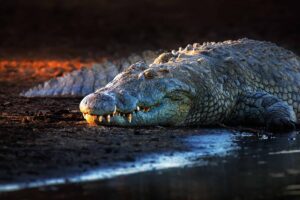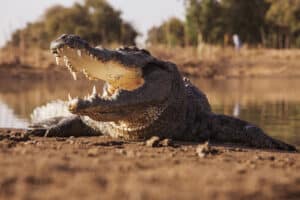Key Points:
- Alligators are the primary crocodilians found in Florida.
- American crocodiles are considered threatened in the state, with only around 2,000 individuals remaining.
- Confirmed cases of Nile crocodiles in Florida have been reported.
Alligators are common in Florida lakes and on some golf courses. American crocodiles, on the other hand, are quite rare. There is an estimated 1.3-1.5 million alligators in Florida, but there are only 1,550-2,000 American crocodiles left. They are considered a Threatened Species by the IUCN.
Crocodiles have a reputation for being more aggressive than alligators and while American crocodiles do not cause many problems, Nile Crocodiles are another story. So are there Nile Crocodiles in Florida Lakes? Have researchers ever confirmed Nile Crocodiles in Florida? Could the next invasive threat to Florida Lakes be Nile Crocodiles? Let’s find out!
How can you tell an alligator from a crocodile?
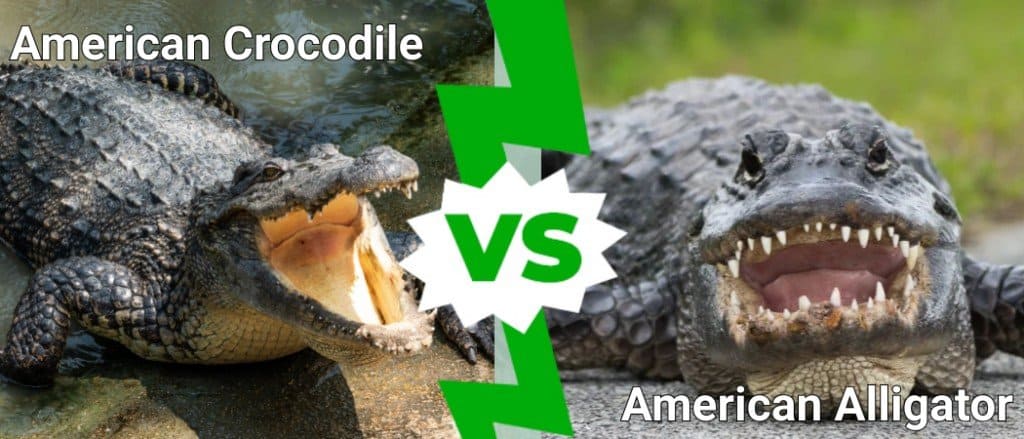
Typically you can tell if a large reptile is an alligator or crocodile based on where you are. If you are in Louisiana, Alabama, Georgia, or most of Florida it is usually an alligator. Taking a river cruise down the Nile in Africa then it is going to be a crocodile.
Are there crocodiles in Florida? Yes. The southern tip of Florida is the only place in the world where crocodiles and alligators live in the same place. Alligators are smaller, darker, and have a rounder, flatter snout while crocodiles are larger, lighter in color, and have a long narrow snout. That may help with the alligator vs crocodile but some people have reported “unusual crocodiles” in Florida. Could these be Nile crocodiles?
What is the difference between a Nile crocodile, American crocodile and Alligator?
| Nile Crocodile | American Crocodile | American Alligator | |
|---|---|---|---|
| Size | Up to 20 feet long | 14-20 feet | 8-11 feet |
| Weight | Up to 2,200 lbs | 300-2,000 lbs | 400-800 lbs |
| Coloration | Olive to grayish with crossbars | Grayish green, lighter than alligators | Blackish in color, darker than crocodile |
| Diet | Fish, birds, small hippos, small zebra, other crocodiles | Fish, birds, frogs, turtles, small-large mammals | Fish, birds, turtles, small mammal |
| Where it lives | Freshwater in Africa, along the Nile river | Southern tip of Florida, Mexico, Central America, Norther South America | Freshwater, southeastern United States |
Are there Nile Crocodiles in Florida?

Nile crocodiles can get to be 20 feet long. They are the second-largest crocodile species.
©Martin Mecnarowski/Shutterstock.com
There are a few confirmed cases of Nile crocodiles in Florida. DNA results prove that three crocodiles that were found near Miami in 2009, 2011 and 2014
What is the story behind four of the Nile Crocodiles in Florida?
- Nile Croc #1: (1996/1997) A Nile crocodile escaped from the Billie Swamp Safari, Seminole Reservation, Hendry County, and slipped away into the swampy 1,012 acre property. This reservation area was contained so there was no imminent danger to the public. Four years later, in 2000 the same croc turned up and was recaptured. The staff estimated that it was 1.2-1.5 m (4-5 feet)when it escaped and when they found it in 2000 it measured 3 meters.
- Nile Croc #2: (April 14, 2009) The second crocodile that researchers looked at was caught on a neighbor’s porch, in Miami by Robert Freer. It was taken to Kliebert’s Turtle and Alligator Farm in Hammond, Louisiana where researchers were later able to get a tissue sample in 2015.
- Nile Croc #3: (October 27, 2011) A female crocodile was captured at the Preston B. Bird/Mary Heinlein Fruit and Spice Park, Homestead, in Miami-Dade County. It was measured at 3.8 feet and weighed 9.7 lbs.
- Nile Croc #4: (March 13, 2014) Another female crocodile was captured in Homestead, Miami-Dade County in a nearby canal. This one measured 2.8 feet. It was released and then captured again a year later in the Everglades National Park. After a year it now measured 5.5 feet and weighed 37 lbs. The researchers examined its stomach contents and found largemouth bass.
What did the DNA results find?
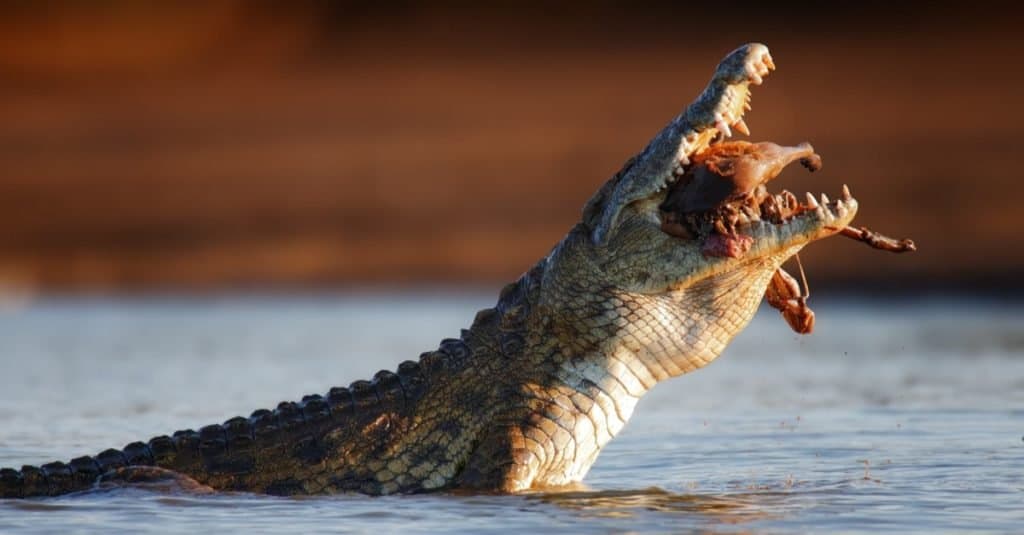
Nile crocodiles (Crocodylus niloticus) were confirmed by DNA testing in Florida.
©Mari Swanepoel/Shutterstock.com
The DNA results from Croc 2-4 confirmed that they were indeed Nile Crocodiles. Croc 3 and 4 were related and it is likely that Croc 2 was also related although the proof was inconclusive.
Does this mean there are Nile Crocodiles in Florida now?
This research helps show that Nile crocodiles could live in Florida and survive quite well. Croc # 1 survived on its own for 4 years and Croc. #4 was living the good life for a year before being captured again. A herpetologist from the University of Florida, Kenneth Krysko, reported in an article in The Guardian that “The odds that the few of us who study Florida reptiles have found all of the Nile crocs out there is probably unlikely.” There is a chance that they are reproducing and creating a new invasive threat to Florida lakes. The Burmese python is an example of another invasive species wreaking havoc in Florida.
Are there Burmese pythons in Florida?
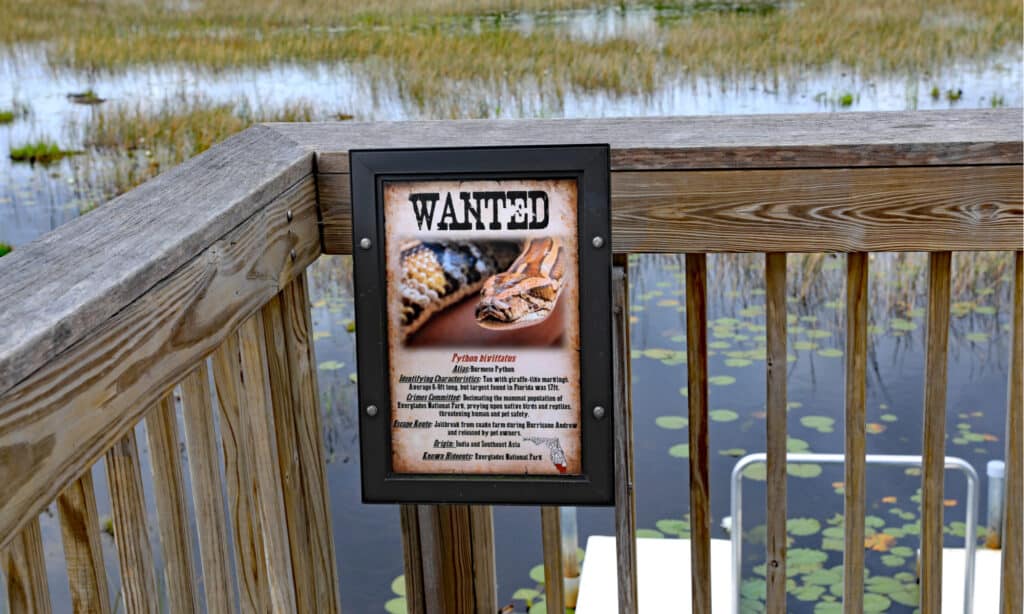
Burmese
Pythons do live in the Everglades in Florida. They are a destructive invasive species killing native animals some of which are endangered.
©Thomas Barrat/Shutterstock.com
Yes! Burmese pythons are enormous constrictor snakes from Asia, India, Vietnam, and southern China. They are not native to Florida and are causing a lot of problems in the Everglades. Most are 6-8 feet long but some can get to be 18 feet long! And they are not skinny jump-rope thin snakes–they are thick-bodied snakes. How do you get an 18-foot-long snake through airport security? You don’t.
The theory is that these were brought to the US as babies or juveniles in the pet trade and then released into the wild (or escaped). The first confirmed Burmese Python in Florida was in 1979. Now, 43 years later there are tens of thousands! They are wrecking plant life and killing thousands of native animals. The USGS reports, “In a 2012 study, populations of raccoons had dropped 99.3 percent, opossums 98.9 percent, and bobcats 87.5 percent since 1997. Marsh rabbits, cottontail rabbits, and foxes effectively disappeared.”
Could we see tens of thousands of Nile Crocodiles in Florida in 20 years?
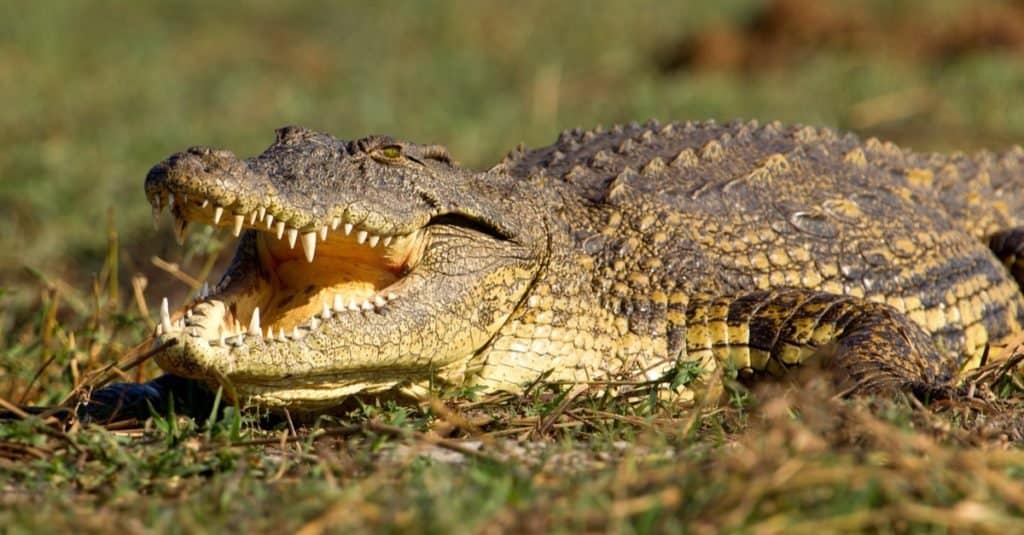
There could be a large population of Nile crocodiles in Florida in the future.
©Gaston Piccinetti/Shutterstock.com
It’s possible we could see a large population of Nile crocodiles in the Everglades in Florida. They could mimic the Burmese Python invasion. Nile crocodiles are apex predators meaning they would have few if any predators here in the US and could adapt to eating deer instead of zebra, small manatee instead of hippos, and maybe even kill and eat smaller alligators or threatened American crocodiles. However, for now, there haven’t been any confirmed captures of Nile crocodiles in recent years, so this is more of a “potential” threat for now.
Largest Nile Crocodile
In 1905, a male crocodile weighing around 2,400 lbs was caught and killed in Tanzania. This large crocodile was the largest recorded Nile crocodile measuring over 21 feet in length! While this crocodile was caught and measured, there is a legendary croc that roams the shores of Lake Tanganyika and the Ruzizi River. Gustave, as he is known, has been reported to have killed over 300 humans and definitely measures over 20 feet long.
How Long Do Nile Crocodiles Live?
As far as reptiles go, Nile crocodiles live pretty long lives. Pythons only make it to two decades in general, while Komodo dragons generally make it to three.
Nile crocodiles on the other hand have been known to live for as long as 45 years in the wild and 60 years in captivity which is rather impressive. That said, alligators get to live even longer and can live for as long as 50 years in the wild, and 80 in captivity.
Why are Nile Crocodiles More Dangerous?
Besides the enormous negative impact the Nile crocodile could have on the delicate ecosystem of the Everglades, Nile crocodiles can be a greater threat to local human populations. Nile crocodiles are very aggressive and won’t hesitate to attack, kill and eat humans in African countries. They are responsible for 200 deaths a year in Africa and around 63% of Nile crocodile attacks are fatal.
If we are unable to contain them, these crocodilians could pose a huge threat to human lives. Hopefully, the 4 identified Nile crocs were isolated instances and conservationists will be able to monitor the wildlife in the Everglades and across Florida.
Bonus: The Most Dangerous Man-Eating Croc is Still Alive and Hungry
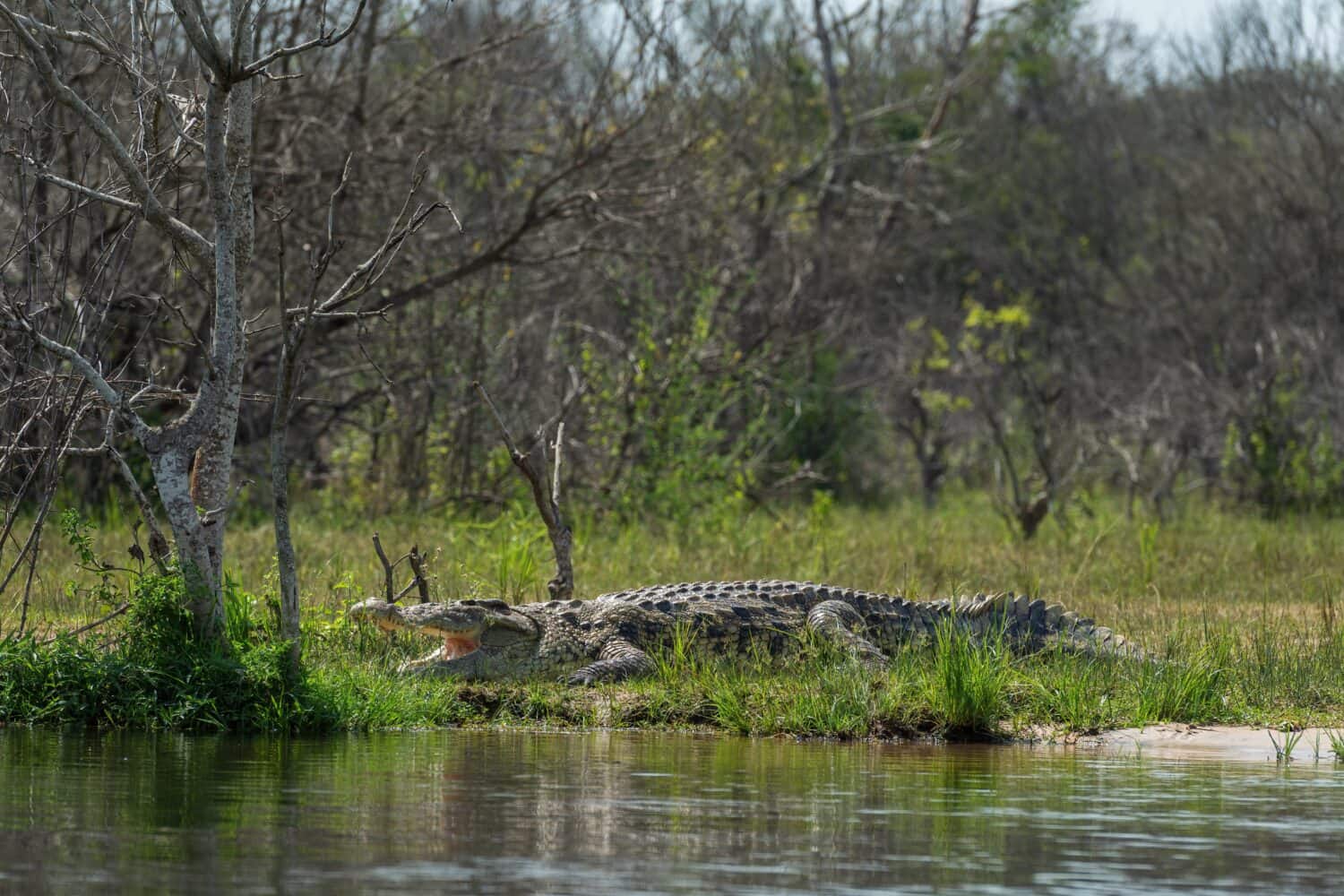
Gustave is a Nile crocodile that has killed over 200 people.
Image: David Havel, Shutterstock
©David Havel/Shutterstock.com
Odds are that more than one Nile crocodile is swimming unnoticed in the Florida Everglades right now. Hopefully, someone is hunting the few that may dwell there – before the worst happens. As we learned from the python invasion – one or two can turn into hundreds before you know it. Alligators and pythons are hard enough to deal with – but what if Florida becomes an unwilling habitat for the biggest, most aggressive, most dangerous reptile on the planet? Could another Gustave reign terror on the Sunshine state?
In case you haven’t heard, Gustave is a notorious Nile crocodile behind over 200 fatal attacks on humans in the Burundi region of Africa. He rules Lake Tanganyika and the Ruzizi River with an iron jaw – sometimes attacking and killing humans just for the fun of it. Most of the time it is because he is hungry. Despite many attempts, Gustave has never been caught and wears three bullet wounds as a testament to his almost immortal stamina. He is estimated to be 20 feet long and weigh more than 2,000 pounds. Researchers thought him to be around 100 years old but have since learned that he still sports an entire set of teeth – making him around 60.
Gustave is so big that he has difficulties hunting regular croc fare like antelope, fish, and zebra – so he goes for hippos, buffalo, and people. What would be the prey of Nile Crocodiles in the Florida Everglades? Deer, wild horses, alligators, manatees – there is plenty to keep a big croc satisfied. Hopefully, humans won’t be added to the menu.
The photo featured at the top of this post is ©
Thank you for reading! Have some feedback for us? Contact the AZ Animals editorial team.




